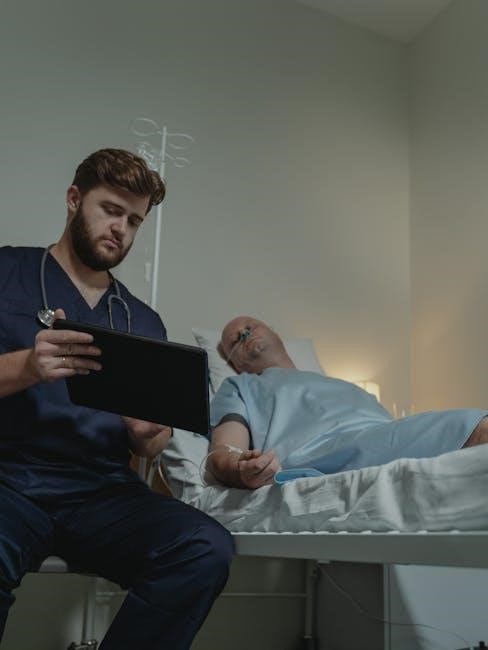Ultrasound-guided IV insertion is a modern technique enhancing traditional methods by using real-time imaging to locate veins accurately․ This training equips nurses with essential skills to improve patient care․
1․1 Overview of Ultrasound-Guided IV Insertion

Ultrasound-guided IV insertion involves using real-time ultrasound imaging to visualize veins and guide catheter placement, enhancing accuracy and reducing complications․ This technique is particularly useful for patients with difficult venous access, such as those with deep or fragile veins․ Nurses use a portable ultrasound machine to locate and assess veins before insertion, ensuring proper placement․ The process involves scanning the arm, identifying suitable veins, and inserting the IV catheter under direct visualization․ This method minimizes discomfort and improves patient safety․ Training programs often include simulation-based learning to master the technique․ By combining anatomical knowledge with ultrasound skills, nurses can perform IV insertions more efficiently․ This approach is increasingly adopted in healthcare settings to improve patient outcomes and streamline care delivery․ Effective use of ultrasound guidance requires hands-on practice and a strong understanding of vascular anatomy․
1․2 Importance of Ultrasound Guidance in IV Insertion
Ultrasound guidance significantly enhances the accuracy and safety of IV insertions, particularly for patients with challenging venous anatomy․ By providing real-time visualization, it reduces the risk of complications such as nerve damage or hematoma․ This method is especially critical for patients with difficult venous access, including those with deep or thrombosed veins․ Improved first-attempt success rates minimize patient discomfort and streamline clinical workflows․ Additionally, ultrasound guidance lowers the likelihood of multiple needle sticks, enhancing patient satisfaction and reducing anxiety․ It also enables nurses to identify suitable veins more efficiently, even in scenarios where traditional methods fail․ Overall, ultrasound-guided IV insertion promotes better patient outcomes, reduces procedural complications, and improves the overall quality of care․ Its adoption is increasingly recognized as a best practice in modern healthcare settings․

Benefits of Ultrasound-Guided IV Insertion Over Traditional Methods
Ultrasound guidance offers higher success rates, fewer complications, and improved patient comfort compared to traditional IV insertion methods, making it a superior choice in clinical settings․
2․1 Improved Success Rates in IV Placement
Ultrasound-guided IV insertion significantly enhances success rates, particularly in patients with challenging venous access․ Real-time imaging allows nurses to visualize veins more accurately, reducing missed attempts and first-stick failures․ Studies demonstrate that ultrasound guidance increases the likelihood of successful IV placement, especially in individuals with difficult anatomy or dehydration․ This method is particularly beneficial for pediatric and geriatric patients, where traditional methods often fail․ By minimizing the need for multiple attempts, nurses can reduce patient discomfort and anxiety․ Moreover, the use of ultrasound decreases the reliance on landmarks, which can be unreliable due to anatomical variations․ The improved accuracy also leads to faster procedures, enabling healthcare teams to initiate treatments more promptly․ Overall, ultrasound guidance is a game-changer in IV placement, ensuring higher success rates and better patient outcomes compared to traditional blind insertion techniques․
2․2 Reduced Complications and Risks
Ultrasound-guided IV insertion minimizes complications and risks associated with traditional methods․ By providing real-time visualization of veins and surrounding structures, it reduces the likelihood of accidental nerve or arterial puncture․ This technique significantly lowers the risk of complications such as hematoma, phlebitis, and infiltration, which are common with blind or landmark-based insertions․ Additionally, ultrasound guidance decreases the need for multiple attempts, reducing patient discomfort and the risk of infection․ The ability to avoid difficult or damaged veins also minimizes the risk of central line-associated bloodstream infections (CLABSIs)․ Overall, the use of ultrasound enhances safety, leading to fewer adverse events and improved patient outcomes․ This makes it particularly advantageous for high-risk patients or those with challenging venous anatomy, ensuring a safer and more reliable IV placement process compared to conventional methods․
2․3 Enhanced Patient Satisfaction and Comfort
Ultrasound-guided IV insertion significantly enhances patient satisfaction and comfort by minimizing the discomfort associated with traditional methods․ The use of real-time imaging allows nurses to locate veins more accurately, reducing the need for multiple needle attempts and associated pain․ Patients often report less anxiety and stress during the procedure, as the process is quicker and more precise․ Additionally, the ability to visualize veins clearly reduces the likelihood of missed attempts, which can be distressing for patients․ This method is particularly beneficial for patients with difficult venous access, such as children, elderly individuals, or those with anatomical variations․ Furthermore, the reduction in complications like hematoma or nerve injury contributes to a more positive patient experience․ Overall, ultrasound-guided IV insertion fosters a more comfortable and reassuring experience, improving patient satisfaction and trust in the care provided․ This advanced technique aligns with patient-centered care principles, prioritizing comfort and reducing procedural distress․

The Role of Nurses in Ultrasound-Guided IV Insertion
Nurses play a critical role in ultrasound-guided IV insertion, utilizing real-time imaging to accurately locate veins, enhancing success rates and patient care through specialized training and skill mastery․
3․1 Responsibilities of Nurses in Performing Ultrasound-Guided IV Insertion
Nurses are responsible for assessing patient suitability for ultrasound-guided IV insertion, positioning patients optimally, and operating the ultrasound machine to visualize veins․
- They must maintain asepsis during the procedure to prevent infections․
- Nurses interpret ultrasound images to identify suitable venipuncture sites․
- They insert the IV catheter under real-time ultrasound guidance, ensuring accuracy and patient safety․
- Documentation of the procedure and patient response is essential․
- Nurses also provide post-procedure care and monitor for complications․
Continuous learning and adherence to best practices are critical for mastering this skill and improving patient outcomes․
3․2 Essential Skills Required for Nurses to Master the Technique
Mastery of ultrasound-guided IV insertion requires a combination of technical, clinical, and interpersonal skills․ Nurses must possess a strong understanding of ultrasound fundamentals, including equipment operation and image interpretation․
- Proficiency in adjusting ultrasound settings and optimizing image quality is critical for visualizing veins accurately․
- Effective communication skills are essential to reassure patients and explain the procedure, ensuring comfort and cooperation․
- Nurses need sound anatomical knowledge to identify suitable venipuncture sites and avoid complications․
- Manual dexterity and precision are required for successful catheter insertion under ultrasound guidance;
- Attention to sterility and infection control practices is vital to maintain patient safety․
- Problem-solving skills are necessary to handle challenging cases, such as difficult venous access․
- Continuous learning and adaptability to stay updated with evolving techniques and technologies are also important․
By refining these skills, nurses can consistently perform safe and effective ultrasound-guided IV insertions, enhancing patient care outcomes․

The Training Process for Ultrasound-Guided IV Insertion
The training process combines theoretical learning, hands-on practice, and simulation, culminating in clinical application to ensure proficiency in ultrasound-guided IV insertion techniques․
4․1 Overview of the Training Curriculum
The training curriculum for ultrasound-guided IV insertion is structured to ensure nurses gain both theoretical knowledge and practical proficiency․ It begins with foundational concepts, such as ultrasound physics and anatomy, followed by hands-on sessions to develop vein visualization skills․ The program incorporates simulation-based training to practice insertion techniques in a controlled environment, reducing errors and building confidence․ Clinical application is emphasized, allowing nurses to apply their skills in real-world settings under supervision․ The curriculum is designed to progressively increase complexity, addressing challenges like anatomical variations and difficult venous access․ Continuous feedback and assessment are integral to ensure mastery․ This comprehensive approach ensures nurses are well-prepared to perform ultrasound-guided IV insertions safely and effectively, improving patient outcomes and reducing complications․
4․2 Theoretical Knowledge Component
The theoretical component of the training provides nurses with a solid understanding of ultrasound principles, human anatomy, and IV insertion fundamentals․ Nurses learn about ultrasound physics, including wave propagation and image interpretation, to effectively visualize veins․ Anatomical studies focus on identifying peripheral veins and understanding variations․ The curriculum covers infection control measures, patient safety protocols, and legal considerations․ Additionally, nurses are educated on the benefits of ultrasound guidance over traditional methods, such as reduced complications and improved success rates․ This knowledge forms the foundation for practical skills, ensuring nurses can apply their learning safely and effectively in clinical settings․ Theoretical sessions include case studies and interactive modules to enhance comprehension and retention, preparing nurses for hands-on training and real-world application․
4․3 Hands-On Practice and Practical Sessions
Hands-on practice is a critical component of ultrasound-guided IV insertion training, allowing nurses to apply theoretical knowledge in real-world scenarios․ Practical sessions typically begin with familiarization of the ultrasound machine and probes, followed by guided exercises to practice vein visualization and needle placement․ Nurses engage in supervised practice using phantoms or simulation arms to refine their technique․ As skills progress, nurses perform IV insertions on real patients under instructor supervision, ensuring patient safety and procedural accuracy․ Feedback is provided immediately to correct errors and improve precision․ These sessions emphasize proper patient positioning, probe manipulation, and maintaining sterility․ Practical training builds confidence and competence, enabling nurses to master the technique and apply it effectively in clinical settings․ The goal is to ensure nurses can safely and successfully perform ultrasound-guided IV insertions in diverse patient populations․
4․4 Simulation-Based Training (SBT) for Skill Mastery
Simulation-Based Training (SBT) is an advanced method in ultrasound-guided IV insertion training, allowing nurses to practice and refine their skills in a controlled, risk-free environment․ High-fidelity simulators mimic real patient scenarios, enabling nurses to encounter various anatomical variations and challenging vein conditions․ These simulations replicate real-world complexities, such as difficult venous access or patient movement, helping nurses develop adaptive skills․ SBT sessions are often video-recorded for post-session analysis, providing nurses with detailed feedback on their technique․ The use of standardized checklists ensures objective assessment of their performance․ This method not only enhances technical proficiency but also improves decision-making and confidence․ By mastering skills in a simulated setting, nurses are better prepared to handle diverse clinical situations effectively, reducing complications and improving patient outcomes․ SBT is a valuable tool in bridging the gap between theoretical knowledge and practical application, ensuring nurses achieve skill mastery․
4․5 Clinical Practice and Real-World Application
Clinical practice and real-world application are critical final steps in ultrasound-guided IV insertion training, allowing nurses to apply their skills in actual patient care settings․ This phase involves inserting IVs under the guidance of experienced mentors, ensuring adherence to infection control protocols and patient safety standards; Nurses learn to adapt their techniques to diverse patient populations, including pediatric, geriatric, and obese patients, where vein visualization and access may be particularly challenging․ Real-world application reinforces the importance of proper patient positioning, ultrasound probe handling, and vein selection․ Success stories highlight how this training reduces complications, such as missed attempts and infiltration, while improving patient satisfaction․ By integrating theoretical knowledge with hands-on experience, nurses achieve mastery and confidence in performing ultrasound-guided IV insertions, ultimately enhancing the quality of care delivered in clinical settings․

Common Challenges in Ultrasound-Guided IV Insertion Training
Common challenges include difficulties in visualizing veins due to anatomical variations and maintaining sterility during the procedure, which require specialized training and consistent practice to overcome effectively․
5․1 Difficulties in Visualizing Veins and Anatomical Variations
Visualizing veins during ultrasound-guided IV insertion can be challenging due to anatomical variations, such as deep or fragile veins, especially in patients with difficult venous access (DVA)․ Obesity, edema, or scar tissue may obscure vein visibility, complicating the procedure․ Additionally, anatomical differences, such as bifurcated or tortuous veins, require advanced skill to navigate effectively․ Nurses must develop expertise in adjusting ultrasound settings, such as depth and gain, to optimize vein visualization․ Proper patient positioning, such as elevating the arm or using a tourniquet, can enhance visibility․ Training programs often emphasize techniques like vein anchoring to stabilize veins during insertion․ Continuous practice and exposure to diverse patient anatomies are essential for mastering these challenges and improving success rates in ultrasound-guided IV insertion․

5;2 Challenges in Maintaining Sterility and Infection Control
Maintaining sterility during ultrasound-guided IV insertion is critical to prevent infections․ Nurses face challenges such as handling the ultrasound probe while preserving a sterile field․ The probe must be disinfected properly before and after use to avoid contamination․ Additionally, ensuring the sterile gel is applied correctly without compromising the field is essential․ Nurses must also prevent the probe from touching non-sterile surfaces, which can introduce pathogens․ Proper hand hygiene and the use of gloves are vital, yet managing these while operating the ultrasound requires skill․ Training programs emphasize techniques to maintain sterility, such as using probe covers and sterile solutions․ Despite these measures, human error can occur, highlighting the need for rigorous adherence to infection control protocols․ Continuous education and practice are essential to mitigate these challenges and ensure patient safety during the procedure․
5․3 Solutions and Strategies to Overcome These Challenges
To address the challenges in ultrasound-guided IV insertion, targeted training programs can be implemented․ Simulation-based training allows nurses to practice in a controlled environment, enhancing their proficiency without patient risk․ Regular skill assessments ensure nurses maintain high standards, while feedback sessions help identify areas for improvement․ The use of checklist protocols during procedures can standardize the process, reducing errors and ensuring consistency․ Technological advancements, such as high-resolution ultrasound machines, improve vein visualization, especially in difficult cases․ Encouraging collaborative learning environments where nurses share tips and experiences fosters continuous improvement․ By integrating these strategies, nurses can overcome challenges, leading to higher success rates and improved patient outcomes․

Tips for Nurses to Master Ultrasound-Guided IV Insertion
Proper positioning of patients and equipment is crucial․ Effective use of ultrasound machines and probes ensures accurate vein visualization․ Continuous learning and hands-on practice enhance proficiency and confidence․
6․1 Proper Positioning of the Patient and Equipment
Proper positioning of the patient and equipment is essential for successful ultrasound-guided IV insertion․ The patient should be placed in a comfortable position that allows easy access to the veins, often with the arm extended and supported․ The ultrasound machine should be positioned directly in front of the nurse to enable clear visibility of the screen without straining․ Adjusting the height of the bed or using an armrest can help maintain ergonomic positioning for both the patient and the nurse․ Additionally, ensuring the ultrasound probe is held correctly and stabilized during the procedure minimizes movement and improves accuracy․ Proper positioning not only enhances the nurse’s ability to visualize the veins but also reduces discomfort for the patient, making the procedure more efficient and effective․ This step is foundational for achieving successful IV placement and maximizing patient comfort․
6;2 Effective Use of the Ultrasound Machine and Probes
Mastering the use of the ultrasound machine and probes is critical for successful IV insertion․ Nurses should first ensure the machine is set to the appropriate settings, such as B-mode imaging, and adjust the depth and gain to optimize vein visualization․ Selecting the right probe is equally important; a high-frequency linear probe is typically preferred for superficial veins․ Properly sterilizing and preparing the probe before use is essential to maintain infection control․ During the procedure, the probe should be held firmly but gently, using a stable hand position to minimize movement; Nurses should also pay attention to the orientation of the probe relative to the vein to ensure accurate imaging․ Continuous practice and familiarity with the machine’s features will enhance proficiency, allowing nurses to quickly identify suitable veins and guide the needle with precision․ This skill is vital for improving patient outcomes and reducing complications․
6․3 Continuous Learning and Skill Improvement
Continuous learning is essential for mastering ultrasound-guided IV insertion, as it ensures nurses stay updated with the latest techniques and technologies․ Participating in regular workshops, training sessions, and simulation-based exercises helps refine skills and address challenges․ Nurses should also seek feedback from experienced colleagues or mentors to identify areas for improvement․ Practical experience is key, as repeated practice builds confidence and competence․ Staying informed about advancements in ultrasound technology and its applications in healthcare is equally important․ By committing to lifelong learning, nurses can enhance their proficiency, reduce complications, and provide better patient care․ This dedication to skill improvement not only benefits individual nurses but also elevates the overall quality of healthcare delivery in clinical settings․

Real-World Applications and Case Studies
Ultrasound-guided IV insertion has demonstrated improved success rates in emergency departments and critical care units, reducing complications and enhancing patient outcomes through effective training programs․
7․1 Success Stories and Examples of Effective Training Programs
Several healthcare institutions have reported significant improvements in IV insertion success rates after implementing ultrasound-guided training programs․ For instance, a pediatric hospital introduced a simulation-based mastery learning (SBML) curriculum, resulting in a 30% increase in first-attempt success rates․ Similarly, an emergency department adopted ultrasound-guided IV insertion training, reducing complications by 25% and improving patient satisfaction․ These programs often combine theoretical instruction with hands-on practice, ensuring nurses gain proficiency in using ultrasound machines and probes effectively․ Real-world case studies highlight how such training enhances clinical decision-making and reduces anxiety for both nurses and patients․ By focusing on practical application, these programs have become a cornerstone in modern nursing education, demonstrating the tangible benefits of ultrasound-guided IV insertion training․
7․2 Case Studies Highlighting the Impact of Ultrasound-Guided IV Insertion
Case studies demonstrate the transformative impact of ultrasound-guided IV insertion in clinical settings․ For example, a hospital implementing this technique observed a 40% reduction in IV insertion complications, particularly in patients with challenging venous access․ Another study highlighted a 35% improvement in patient satisfaction due to reduced pain and discomfort during procedures․ In pediatric care, ultrasound-guided IV insertion significantly lowered anxiety levels in children, as the procedure became quicker and less invasive․ Additionally, a teaching hospital reported a 25% increase in first-attempt success rates among nurses after introducing ultrasound-guided training․ These real-world examples underscore how this technique not only enhances clinical outcomes but also improves the overall quality of patient care, making it a vital skill for modern nursing practice․

Ultrasound-guided IV insertion training is a game-changer for nurses, enhancing patient care and safety․ Future advancements in technology promise even greater efficiency and precision in this critical skill․
8․1 Summary of the Importance of Ultrasound-Guided IV Insertion Training
Ultrasound-guided IV insertion training is vital for nurses, as it significantly improves the accuracy and safety of IV placements․ By reducing complications and enhancing patient comfort, it elevates the quality of care․ This method ensures better visualization of veins, especially in challenging cases, and minimizes the risk of infiltration or nerve damage․ Nurses gain confidence and proficiency through hands-on practice and simulation-based learning, making them more competent in real-world scenarios․ The training also fosters a culture of continuous improvement, encouraging nurses to stay updated with advancing technologies․ Ultimately, ultrasound-guided IV insertion training not only benefits patients but also empowers nurses to deliver superior care, making it an essential skill in modern healthcare settings․ Its widespread adoption promises to revolutionize IV insertion practices, ensuring better outcomes and patient satisfaction․
8․2 Future Directions and Innovations in IV Insertion Technology
The future of IV insertion technology holds promise with advancements in ultrasound-guided systems and AI integration․ Portable, high-resolution ultrasound devices are becoming more accessible, enabling nurses to perform insertions with greater precision․ AI algorithms could analyze ultrasound images to predict optimal vein locations, reducing the learning curve for new nurses․ Additionally, augmented reality (AR) may overlay real-time data onto the patient’s anatomy, enhancing visualization․ Innovations in needle guidance systems, such as automated stabilizers, could further reduce complications․ Training programs may incorporate virtual reality (VR) simulations to provide immersive practice environments․ These technologies aim to improve efficiency, reduce risks, and enhance patient comfort, ensuring that IV insertion becomes safer and more effective․ By embracing these innovations, the healthcare industry can continue to elevate the standard of care and empower nurses with cutting-edge tools․